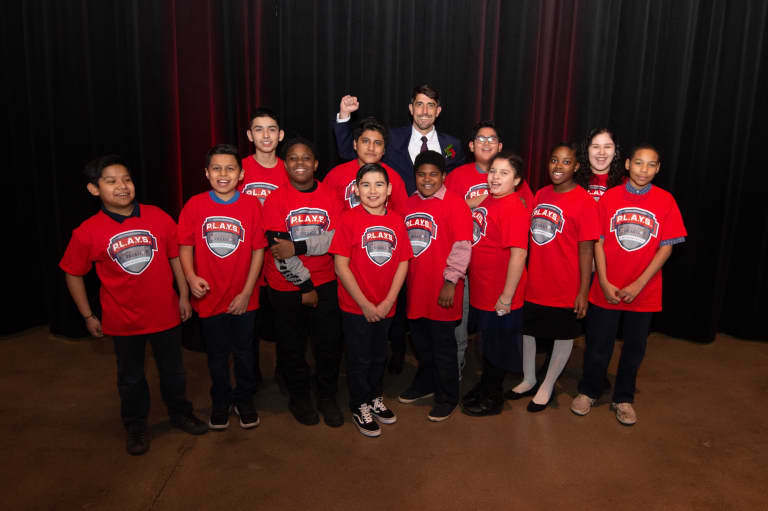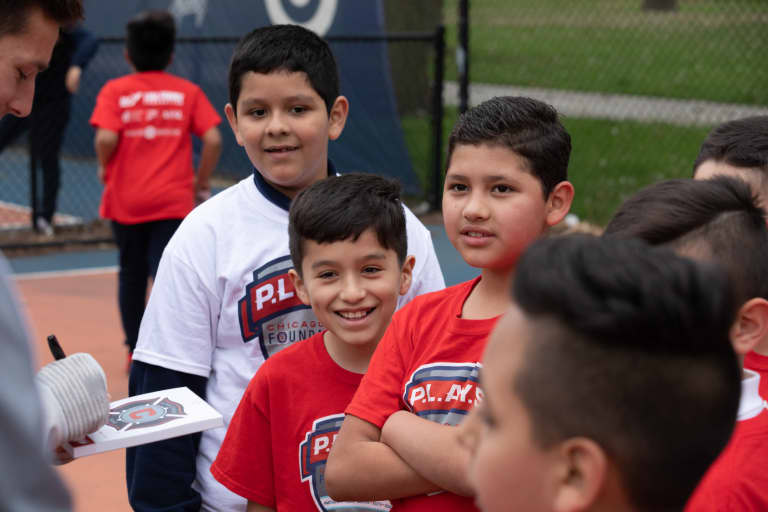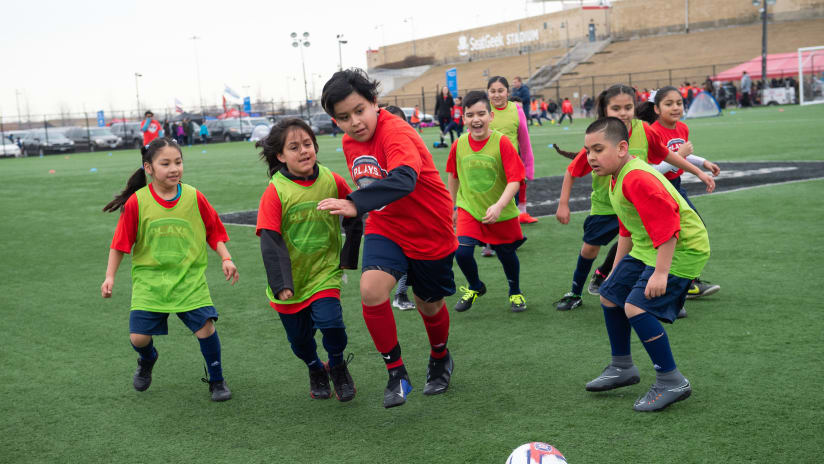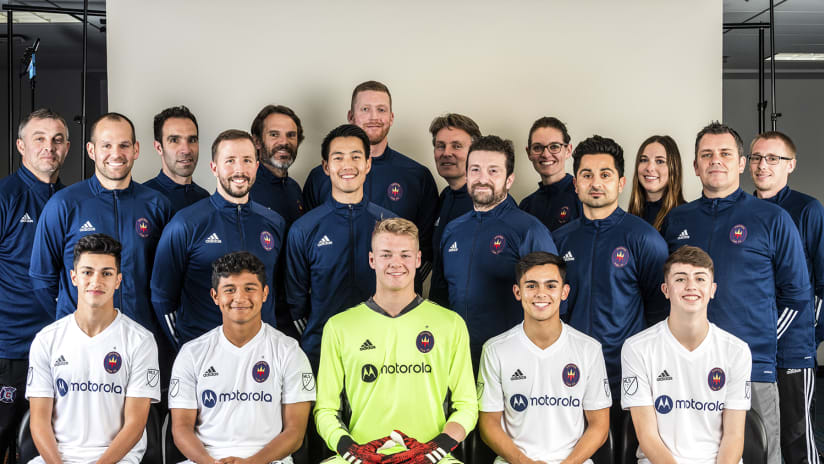It was a big day for Chicago Fire. On Tuesday morning, various staff assembled in the office of COO John Urban to coordinate outreach to the extended Fire family, about significant news on our lease with the Village of Bridgeview. But even as we headed back to our desks, waiting for the moment to send out the news, John and Fire Foundation Executive Director, Jessica Yavitz, were packing their laptops into carry-on bags and preparing to make their stadium update calls en route to the airport — destination Los Angeles, and the ESPN Sports Humanitarian Awards ceremony.
Later that evening, as I headed back to my car after attending a Section 8 board meeting, the news came through that Chicago Fire had been selected as the 2019 Sports Humanitarian Team of the Year — receiving a $100,000 grant, which will be put directly to our P.L.A.Y.S. program. Being selected above all other professional and amateur sports teams in the U.S. was just the latest recognition for a program that also won international recognition at last year’s Leaders Sports Awards in London, and has become a model for best practice.
The Chicago Fire Foundation was the first of its kind in the league, and Jessica has been with the club virtually since its inception. Since 2013, the Foundation, which originally administered donations made by the club to organizations throughout Chicagoland, has been self-funding and directing a program called P.L.A.Y.S (Participate, Learn, Achieve, Youth Soccer) supporting vulnerable schools and communities within the Chicago public school system.
Earlier this year, as the Fire prepared to face New York Red Bulls on a chilly, early spring day, I remembered walking past a row of yellow school buses unloading crowds of kids and parents at the Fire practice fields. Some 1,500 neighbors were guests of the Fire that day — playing games against each other on the turf practice fields, then eating a meal and attending the game as the club’s honored guests.

The scene was loving chaos. As I arrived over to the fields outside the training dome (itself fully occupied with P.L.A.Y.S. activity that morning), I was struck by the cacophony of excited kids' voices coming from the clusters of luminous training bibs scurrying around the fields.
If you’re a fan, you’ll watch any game, anywhere, regardless of who is playing. I’ve taken an hour to buy milk from the corner store on my block before, because I stopped to watch a pick-up game in my local park. But it was quickly clear that watching those games to pick out the next Bastian Schweinsteiger was not the point. The kids were having fun as they swarmed around the ball, but as Jessica is very clear, P.L.A.Y.S. Program soccer is primarily there to capture the imagination, fuel self-esteem, and teach life skills.
“We have initiatives like Fire Juniors and the Academy to spot and develop a young player to have a good left foot,” says Jessica. “In P.L.A.Y.S. our training manuals might be as simple as ‘This is how you lay out cones for 4v4’ because we’re using teachers in our schools who mostly aren’t soccer coaches. There’s a few, but many of them are not and have never played. Never touched a ball until they did the program. Even the teacher who spoke at our Gala this year is not a soccer person. She even said in her speech, ‘[fellow] Coach Andrew is the soccer person — I’m social and emotional.’ That’s one of the things that sets us apart. It makes it more about the impact upon them as an individual holistically, rather than whether or not they can kick a ball perfectly.”
Coach Nakisha Faulkner is in her second year working with the program. As I arrived in the Dome she was pulling together a group of students from Curtis School to go through warm up exercises before their first game. Coach Nakisha had taken over from another member of staff on short notice last year. She’d never followed or played soccer and as she put it, “I had some doubts in not really knowing what to expect. But Jessica walked me through every step and eased my fears. And the Foundation provided everything we needed.”
Every kid in the program gets a uniform, a ball and a logbook that outlines some of the developmental themes of the program as well as offering a “Trophy Room,” for which the young participants can get stickers marking their progress. Some 720 kids from 30 schools are currently served by the program.

P.L.A.Y.S. initially started as a pilot program in eight schools in 2013. After the Hauptman family had expressed an interest in the Foundation performing more targeted philanthropy, Jessica and her team developed P.L.A.Y.S. to service a need in under-resourced Chicago public schools that had been placed under the banner of Academy for Urban School Leadership (AUSL).
“When we sat with them,” says Jessica, “it became clear that there was no programming for elementary age students. After-school activities didn’t kick in until middle school. Research had shown that third grade is a pivotal point in their development, and if you can get them there and keep them going, that’s going to help improve their overall life chances and academic chances. So, was there something we could do as a partnership that was helping with the child as a whole but incentivizing and encouraging through sports?”
George van Allen is a Curtis parent, who I met on the sidelines of the Dome, watching his son Malachai Joseph play. He was happy to be here and enthused at the prospect of seeing the Fire play afterwards, and at the effect the program was having on his son:
“We should have had this when I was younger, man. It’s a good thing, especially for the inner city. We’ve got so much going on that this is a plus that they’re trying to steer kids in the right direction — giving them something to do other than just being on the corners and wearing the parents out. We appreciate it. He loves it. It gets him happy and motivated.”
“They learn teamwork,” says Coach Nakisha. “They’re learning the techniques they’re going to need in real life to communicate. To learn about each other, learn from each other. They build those types of relationships and social skills that some of them are lacking. It brings out their personalities and allows them to feel comfortable in themselves in doing a sport that’s keeping them engaged and fit.” Jessica tries to coordinate these P.L.A.Y.S. invitations for day games to maximize attendance and avoid real safety concerns for children on return journeys — a logistical detail that highlights some of the challenges the children and their parents are facing in their lives.

And when I ask Jessica to give me her personal proudest moment since the inauguration of P.L.A.Y.S. she offers another illustration of just what’s at stake.
“It was probably in about 2015. We were out at our Practice in the Community event in Little Village. Little Village has one of the highest crime rates in Chicago, and right where we program our Practice in the Community, and also run P.L.A.Y.S., is the dividing line between two of the largest gangs in Chicago. And we were out there with the first team and we’d been running programming. And a little boy ran up to his dad, who’d been standing on the side, and said, ‘Dad, we must live in a safe neighborhood if the Fire are out here to see us.’”
“And hearing that from a little boy, who’s in what, by any city measurement, is not a safe neighborhood, and that we gave him that impression from being there in his community…my heart melted to hear that he feels safe to be there and be outside and playing, only because he’s seeing us there. And we’re coming to him, versus assuming that everyone will come to the stadium to see our club. And to hear a little boy say that to his dad, and to hear how excited he was and how good he felt about where he’s from because we were there, was such a great feeling.”
Most “great feelings” we might casually associate with the club come from what the team does on the field, of course. But those feelings start with a sense of connection. And whether on the field, or in the grain of a club’s culture, that has to come from the heart. A player has to buy in wholeheartedly; a club has to sincerely want to be a good neighbor; a family has to see themselves reflected.
So, we had big news about the club’s potential future this week. But we also had big news about what’s happening in the present, that served as a reminder that wherever we stand, we are strongest when we stand together.






